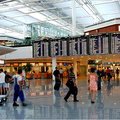Searching the Alps for Haute Comfort Food
THE first thing to do with a tartiflette is to ease your fork through the crust of cheese. If the casserole is done right, that cut will release a whiff of milky steam infused with a suggestion of onion and garlic.
The best moment, though, comes with a perfectly proportioned forkful. A chunk of cream-soaked potato and a smoky bit of lardon will be married with a smooth coat of reblochon — cheese made from the milk of one of three breeds of French cows that march to Alps meadows in the spring and return to hay-filled barns in the winter.
The tartiflette is perhaps the most comforting dish in all of France's Haute-Savoie, and it's what led me to take a three-day tour of small villages in the region in search of what I imagined as a perfect tartiflette. The dish has the tang and satisfaction of macaroni and cheese baked until it forms a chewy crust, the pure pleasure derived from a bowl of creamy mashed potatoes and a flavor that could only come from 500 years spent perfecting cheesemaking.
I was in Annecy, the capital of the region, with my partner, Katia, visiting her cousin Nora in October. Lunch the first day was at Marc Veyrat's three-star Michelin country French temple, and as we worked our way through 15 refined courses (it now costs 338 euros, or about $465 each, at $1.38 to the euro), Nora described the best tartiflette she had ever eaten. It was made by Mr. Veyrat himself, for a little side operation he had back in the early 1990s.
“I can remember nothing else of that restaurant but the tartiflette,” she told us. That's the effect a good tartiflette can have.
The trick is the reblochon, which is sliced over the top before the dish is baked. Reblochon is a soft, washed-rind round cheese about as thick as a paperback copy of “Candide.” A good one has tang and aroma and a slightly salty quality. The bad are as bland and rubbery as cheap brie.
At its best when the cows are eating nothing but Alpine grass, the cheese got its name from 16th-century farmers who were sick of the tax on their milk. They'd milk their cows until they were about halfway done, pay the tax on that bounty and then finish the job.
They had to do something with the remaining milk to avoid charges of tax evasion. So they made cheese, the name of which comes from the word reblocher, which means to milk again. (Some tie the name to the slang term “reblessa,” which in the local dialect basically means to steal.)
To make tartiflette, the whole cheese is sliced in half horizontally and turned cut side down before the dish goes in the oven. The idea is to turn the soft, brushed rind into a crispy crust as the inside of the cheese melts into the cream and coats the potatoes.
For a road-weary traveler looking for a regional dish, tartiflette is inexpensive and accessible. No one can argue with the instant comfort that comes from a bubbling hot dish of cheese, bacon and potatoes.
In dozens of villages around Lake Annecy, people make and sell reblochon. Similarly, the region is crazy for tartiflette. It is a staple on the menus in the small city of Annecy, considered one of the oldest settlements in the Alps.
Bad tartiflette is easy to find. The tourist-driven cafes near the medieval prison in the heart of the historic quarter of Annecy all offer versions with a small salad and sometimes a small plate of charcuterie. I ate enough bad tartiflette that halfway through my search, I threw myself across my bed like fat Elvis.
Things started looking up at Le Fréti, in the pedestrian-only section near the old prison. It had a terrific cheese cellar and three small rooms filled with the smoky smell that comes when half-moons of raclette melt in front of long electric burners.
Local fruity white wine or warm tea is the thing to drink with all the cheese dishes in the Haute-Savoie; otherwise, Nora warned, “you end up with a cheese stone in your stomach.”
We ordered some of both, and I paid about 11 euros for a bubbling tartiflette. The dish was capped with a couple of crusty bits of cheese and had fatty strips of lardon.
It was good, but I felt vaguely disappointed. This wasn't the tartiflette that the food-obsessed argue over on culinary blogs. True, it was an improvement over my grandmother's scalloped potatoes, but I knew there had to be something better.
The next day, we headed to the village of Menthon-St.-Bernard to eat tartiflette with the cows. Not literally, but pretty close.
The owners of Ferme de la Charbonnière take the idea of farmstead dining to an extreme. Want to know where all the cheese on your table came from? Just glance through the plexiglass down to the barn below, where some of the herd is most likely being milked.
The restaurant smells like a mix of broiling cheese and barnyard. An evening sitting on wooden benches and watching the cows brings the notion of terroir to a new level.
There, a tartiflette must be ordered in advance. If you don't call ahead, you can make do with a kind of do-it-yourself tartiflette called “reblochonnade.” Grumpy-looking women haul little charcoal broilers that look like toy ovens to your table, along with reblochon split into two rounds and placed on little skillets. The customer shoves the cheese under the broiler until it melts, then pours it over a boiled potato and adds some slices of soft, dense air-cured ham.
But the dish, like its sister tartiflette, suffered from cheese that was almost as bland as American Muenster.
At this point, I thought perhaps I had been wrong about the tartiflette. I was at the epicenter of tartiflette cooking, and I couldn't find a good one. Perhaps, as I had been warned, tartiflette was nothing more than a marketing ploy invented by the makers of reblochon to sell more cheese.
Then I headed up the mountain toward Montmin, a place that is not much more than a collection of small buildings, some cows and a little ski area for kids. I parked and took a short, steep hike to Col de la Forclaz, mesmerized by the view of blue Lake Annecy far below the mountain pass.
I continued through a clearing and saw a soft asphalt ramp on the edge of the mountain. A driveway to nowhere. Men and women were strapping themselves into what looked like tricked-out baby car seats and running down the ramp, parachuting to the fields far below.
An hour of watching that can make a girl hungry. Besides, the sun was going down and it was getting cold. So I hiked back to a small restaurant, Châlet la Pricaz, a gathering spot in Montmin. The owners have 50 head of Tarine cows, and make their reblochon not far from their restaurant.
Two old French women were the only other customers on that cold Sunday night. I decided to take one more shot.
“Une tartiflette, s'il vous plaît.”
Finally, it came. A brown crockery oval covered in cheese that a hot oven had transformed into a crispy lace crust. The reblochon had character and tang, and had melted into the cream just so, marrying the potatoes and bacon. I had found tartiflette nirvana, with a side of charcuterie.
I paid my 13 euros, said goodbye to the women, and drove back down the mountain. But after three days of almost nothing but cheese and potatoes, I kind of wished I'd hiked.
VISITOR INFORMATION
Le Fréti, 12, rue Ste. Claire, Annecy; (33-4) 50-51-29-52; www.le-freti.com. Open for dinner every day and for lunch on Sundays and public holidays. The tartiflette costs 11.10 euros, about $15.50 at $1.38 to the euro.
Ferme de la Charbonnière, Route de Thônes, Menthon-St.-Bernard; (33-4) 50-02-82-59. Open all year for lunch and dinner. Closed Monday. A meal of charcuterie, tartiflette, salad, cheese and coffee is 17 euros.
Châlet la Pricaz, Col de la Forclaz, Montmin; (33-4) 50-60-72-61; e-mail: lapricaz@fnac.net. Open every day in summer; closes Thursdays in April and May and Wednesday and Thursday from October through March. Tartiflette, 17 euros.






